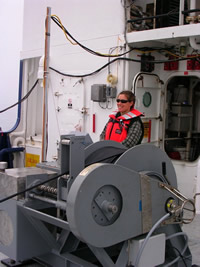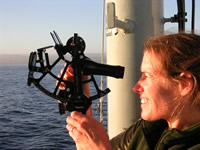


|
The Project
|
August 29, 2005
The sea lions seem very curious about the profiler with its bright orange and green floats. This morning we observed a sea lion swim up to the stern (back) of the boat. Its head came up out of the water and it looked towards us as it scanned over the situation. The sea lion seemed to reposition itself several times for a better look at our activities. After it seemed satisfied with what it saw, it gathered speed and jumped up out of the water and curled down to a perfect deep dive. It seemed that the sea lion had gone on to other things when suddenly it resurfaced for one last look. Maybe it was looking to see if we saw its fantastic dive! I smiled as I thought of how free and graceful the sea lion appears while in the water. I compare this to the only other sea lions that I had ever seen before this trip. The sea lions I remember were limited in their movement as they jostled for a good position on a dock. Today the fog lifted before 11am and soon it was a cloudless day. The science team ‘filled in the gaps’ by profiling many times between two positions in the Bay. Now that we are getting to know the area, we can better pinpoint sections of the bay that we need to examine more closely. As we worked on the lower deck, the sea looked a brilliant blue as the swells gently rolled by the ship. It felt good to be warm for a change. The conditions out at sea change quickly though, and just after our lunchtime meal the ship began rolling and rocking with four-foot waves and strong winds coming from the northwest. In Monterey Bay, it seems, the clearer the day, the strong the winds. Today during the strong winds we headed towards the protected near shore areas to allow the lidar team smooth conditions to adjust their instrument. During times like this, Captain Murray Stein and Melissa Turner (third mate) have been teaching me to use a sextant (a tool for measuring angle) for navigation. Learning to use the sextant was one the goals that I set for myself during this cruise. The sextant is a delicate yet beautiful instrument that is used to measure the altitude (height above the horizon) of a celestial body (the sun, the moon, or a star). With a careful measurement, an exact time, and an estimated position, a person can compare their assumed position with their calculated position and plot a line of position on a map. With three sextant readings during a day, a person can be sure of their position while at sea. Global Positioning System (GPS) is currently the standard navigation tool, however, knowledge of celestial navigation is still required and can be very important in emergency situations. I have learned that learning the art of navigation takes a lot of time and patience. With the time available to me during the next couple of weeks I hope to have mastered at least the basics of celestial navigation. Math: A navigator and most scientists use time set in what is often called military time or twenty-four hour time. In this case, time is named for the hour from midnight. 1 AM is 0100 hour, 12 noon is 1200 hour, 1 PM is 1300 hour, and 12 midnight is 2400 hour. If a navigator takes a sextant reading at 1300 hour and another reading at 1530 hour, how many hours apart were the readings taken? With science and navigation being more global, time is often set to match the time in Greenwich, England. This time is then the same all over the world. Time in this case is called Greenwich Mean Time (GMT) or Universal Time Coordinate (UTC). When taking a sextant reading the UTC time is always used. If it is 1200 hour in the Monterey Bay our UTC time is 1900 hour (add seven hours). If it is 1300 hour in Monterey Bay what is the UTC time?
|


